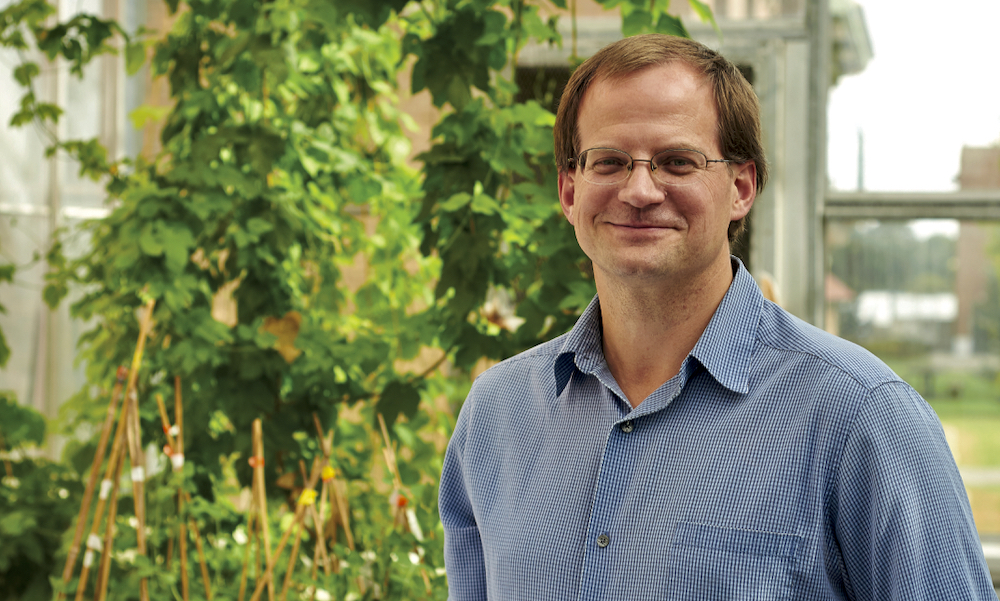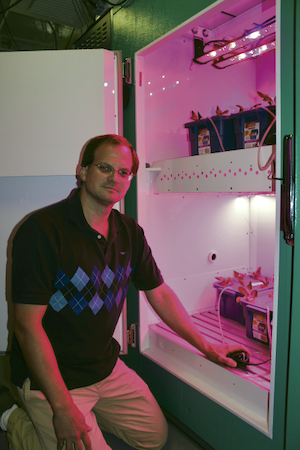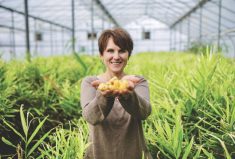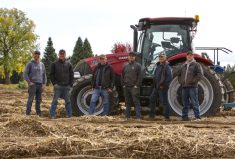Quebec is already a leader in urban agriculture. It has many small urban farms and a number of community-led rooftop gardens, and is home to the world’s first commercial rooftop greenhouse operation, Lufa Farms, which recently expanded into a new 163,000-square-foot greenhouse atop a former Sears warehouse in the St-Laurent area of Montreal. The Quebec government and City of Montreal have also invested $750,000 in urban agriculture development.
In every way, the time seems right. Two big factors have helped spur innovation and growth in urban agriculture in Quebec, particularly in the areas of greenhouses and indoor vertical farming over the past decade or so. The first was the implementation of LED lighting technology, a more cost-effective and efficient system for greenhouses.
“Prior to LED lighting, we had to use fluorescent, high-pressure sodium, metal halide or external light systems,” says Dr. Mark Lefsrud, who leads the Biomass Production Laboratory at McGill University. It focuses on developing new sources of biomass for food, fibre and fuel, and on improving the energy efficiency of greenhouses and indoor plant growth environments.
Read Also

What to consider when setting up farm-related business ventures
Things to consider before launching a farm-adjacent side business.
“They were very energy intensive and produced a lot of heat, so growers needed cooling technology and the lights had to be kept a long distance from the plants. Once LEDs came along, they had technology that allowed them to locate lights right up against the plants because their ambient temperature was much lower, which allows them to grow plants almost anywhere; they are no longer limited by a cooling capacity.”
Quebec also has the advantage of available inexpensive hydroelectricity, since exports to the U.S. have gone down in recent years. With dwindling demand for power, the solution has been to try and add value to the energy produced in the province.

“An easy way to (add value) is to do food production through either greenhouses or indoor agriculture systems,” Lefsrud says. “It allows us to be one of the cheapest electricity-providing locations on the planet, which means that people are now trying to grow almost anything for those reasons.”
Another big shift that has spurred interest in indoor farming is huge investments made by the cannabis industry in new controlled environment technologies.
“It’s the confluence of low energy prices, LEDs, this huge investment on new technologies that have improved all controlled environment spaces, and then we have NASA as the poster child of how far we can push it and it makes it sexy to grow food indoors,” says Lefsrud. “Nobody really cared about it until all these things came together.”
And then there’s local food
Lefsrud was part of the design team that helped develop a vegetable growth unit for NASA to grow plants in space, and he also designed components for the Advanced Plant Habitat on the space station, so he jokes that people have always wanted and always will want to grow food, anywhere.
“It’s always been present, and people started seeing a lot of the drought issues that are happening in California, which supplies a lot of our produce, as well as some of the diseases that we’ve had like e-coli or listeria outbreaks and so people want to get back to the local food thing,” he says.
Without a doubt though, one of the biggest drivers of local urban food systems is the fact that people are increasingly searching out food that has been grown where they live and want to connect with the people that grow it.
“There’s a big local food movement, and people like the idea that they know where their food is coming from and they can go see these places,” Lefsrud says.
Lufa Farms, as an example, offers open houses so people can come and see how their food is grown and meet the growers.
Costs comparable to conventional farms
Although many people think that urban farms are less capital-intensive than large, rural farms, that’s not necessarily the case, depending, of course, on the type of operation. Certainly, indoor agriculture can require some deep pockets
“In the end, they’re fairly compatible,” Lefsrud says of rural and urban farms. “The difference is that you could possibly have a landlord, so you can rent, so the costs can be mitigated a little bit through that. But if you take an old abandoned or derelict warehouse and modify it, the cost to do that on a basic level looks low, but after you get into it and have to meet all the code requirements and such, it becomes almost the same as traditional agriculture. I don’t see any large savings on that.”

It’s also not cheap to run an indoor farm because there is a 24/7 energy requirement and other costs like labour and technology that add up and make it hard to compete with cheaper imported produce.
“In a greenhouse, we can control the environment but our problem is that in the middle of winter, we still get down to -20 C and that takes a lot of energy, so we don’t gain on those things, we lose quite badly there,” Lefsrud says.
But the big advantage, and the thing that helps make indoor farms competitive in the local marketplace is the lack of transportation costs.
“Growers don’t have to transport lettuce heads that come out of California and Mexico all the way across the country,” Lefsrud says. “Because of those savings, they can charge the same price.”
Challenges of indoor food production
Many of the challenges that traditional rural farms face are common to urban indoor farms, with a big one being labour, although, conversely, the urbanization trend that has robbed rural farms and communities of their traditional sources of labour is proving to be more of a benefit to urban farms looking for workers.
“Having these things placed into urban centres has provided a workforce that typically would have been employed locally to help out on the farms,” Lefsrud says. “When people migrated into cities, they seem to be migrating back into these urban-type projects that give them employment and food.”
Even though many people make a living from their urban farm operations, they aren’t likely to get rich.
“You’re still a farmer, you’re dependent on the production of the crops and some of the technology isn’t quite there yet,” Lefsrud says. “It’s economically beneficial but you’re never going to get wealthy doing this. There’s still a lot of improvements that have to be made and it’s one reason why I feel comfortable in my position is because I know that the growers always have questions.”
A future challenge for all agriculture, but especially in controlled, indoor environments, is likely going to be water, Lefsrud says.
“One of the things we have to work on in these indoor systems is how to recover some of the (water) that they use and that is vented into the atmosphere,” Lefsrud says. “They are not allowed to dump waste water into the sewage system; it’s too much for cities to handle, so we need to improve these systems.”

City and municipal planning authorities still have a way to go too in catching up with urban agriculture and its needs. When Quebec’s early pioneers of urban, indoor growing started to appear, the City of Montreal didn’t know how to classify them.
“The city didn’t want to classify them as agriculture. They were unwilling to be classified as pharmaceutical, so they had to create this new area which became urban agriculture,” says Lefsrud.
With the City of Montreal and the Ministry of Agriculture now investing in urban agriculture, a framework is starting to evolve, but there are still issues that urban farm operations run into that have to be figured out, like building codes.
“If you’re built on a third story of a building, is that still considered agriculture or should you be following full civil engineering and mechanical codes and everything else, even though the occupancy is almost zero, there’s just a bunch of plants in there,” Lefsrud says. “That’s one of the big arguments that they’ve been having. Obviously, they are not going to be in the agricultural building code, but they are not positive they should have to follow the full requirements that a traditional high-occupancy building does, so how do we vet those needs and requirements?”
Lefsrud says the urban indoor agriculture industry has a lot of work still to do to develop some standards and remove impediments to future growth.
“How much energy are we allowed to use per square foot? There are still debates on HVAC requirements, load requirements, building, CO2 management, all these things that we thought we had fairly well understood in a greenhouse, but once we put them inside a building then there’s a whole new set of challenges that we have to try to manage,” he says. “It’s still early days.”
Lots of investment happening
Regardless of the challenges still to overcome, there are some big players getting into indoor urban farm operations. There is a lot of interest in vertical farming from major food companies and other private investors. McCain Foods recently invested in GoodLeaf Farms, which has vertical farms in Nova Scotia and Guelph, Ont. Amazon founder Jeff Bezos is an investor in Plenty, a California vertical-farming venture, and a major hedge fund management company recently invested heavily in vertical farming company Aerofarms.
So, with all this investment and growth potential for indoor food production in cities and towns, will it ever be a threat to traditional agriculture? Lefsrud says no, in fact the two can and do complement each other.
“If you take Lufa farms specifically, they can’t meet demand themselves, so they buy from local farmers in the area to meet their basket requirements,” Lefsrud says. “It’s taking away some of the production that is happening in California and Mexico that has been supplying us up to this point, but billions of dollars-worth of lettuce is brought into Canada every year. Even if Lufa doubles and doubles again, they are still not going to take away that market. And (urban agriculture) is never going to compete with cereal grains, potatoes or any of the products that can be stored. These are almost all short shelf-life products that are being produced.”
















